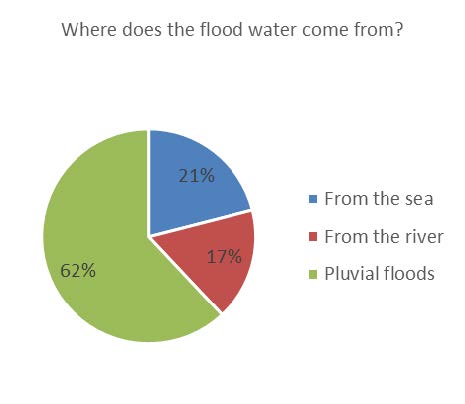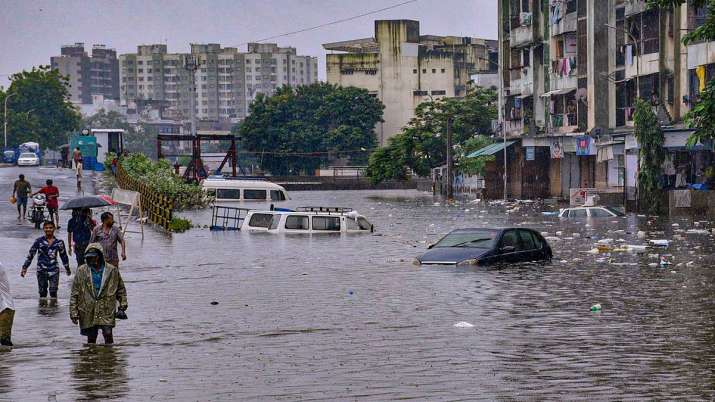
INTRODUCING FLOOD CASES
Overview. Floods are the most frequent type of natural disaster and occur when an overflow of water submerges land that is usually dry. Floods are often caused by heavy rainfall, rapid snowmelt or a storm surge from a tropical cyclone or tsunami in coastal areas.Floods are the most frequent type of natural disaster and occur when an overflow of water submerges land that is usually dry. Floods are often caused by heavy rainfall, rapid snowmelt or a storm surge from a tropical cyclone or tsunami in coastal areas. Floods can cause widespread devastation, resulting in loss of life and damages to personal property and critical public health infrastructure.
It occurs when drainage channels are filled and the rivers and streams can no longer accommodate the excessive water generated by severe weather conditions. The drainage channels then overtop their natural or artificial banks and water enters the surrounding lands to cause flooding.Between 1998-2017, floods affected more than 2 billion people worldwide. People who live in floodplains or non-resistant buildings, or lack warning systems and awareness of flooding hazard, are most vulnerable to floods.

disaster by flood.

india flood graph.

RESCUE OPERATION.

water filled in city

going some were in flood .

disaster .

disaster of flood .

kerala flood.

flood leads area.

some first flood images.

rare flood images.

disaster of flood.

disaster of flood.

disaster of flood.

disaster of flood.

disaster of flood.

disaster of flood.

disaster of flood.

disaster of flood.

disaster of flood.

disaster of flood.

disaster of flood.

disaster of flood.

disaster of flood.

disaster of flood.

disaster of flood.

disaster of flood.

disaster of flood.

disaster of flood.

flood in the urbon area.

bihar flood.

disaster of flood.
case study of flood
Kerala is a state on the southwestern Malabar Coast of India. The state has the 13th largest population in India. Kerala, which lies in the tropical region, is mainly subject to the humid tropical wet climate experienced by most of Earth’s rainforests.
Eastern Kerala consists of land infringed upon by the Western Ghats; the region includes high mountains, gorges, and deep-cut valleys. The wildest lands are covered with dense forests, while other areas lie under tea and coffee plantations or other forms of cultivation.
CAUSES
Floods – Definition and Different Causes of Floods causes Flood is a term used to denote an enormous amount of water. When there is an outflow of water in a place, it is said to be flooded. The situation caused when the water becomes uncontrollable is said to be flooded. The flood may take different forms such as in the form of heavy rainfall when there is a breaking of the dam. Furthermore, the melting of snow also leads to flooding. Floods lead to an overfull and huge spread of water but are not considered safe for the purpose of drinking. Thus floods bring with them a number of diseases such as typhoid, cholera and many others. Here, we shall discuss the various causes of floods.
CAUSES OF FLOOD Flood is usually a result of natural causes. It may also be caused by man-made factors. It causes huge damage to life and property. There are many different causes leading to flooding. Some prominent among them include:Massive Rainfall Drainage systems and the effective infrastructure design aid during heavy rains. They help the drainage of excess water into reservoirs in an easy way. But in cases of heavy rainfall, the systems stop working. Thus flood is caused.
Overflowing of the Rivers The people living along the river always have a risk of life from the overflowing of the Rivers. To prevent such a situation, a string of dams are built. However, if these dams are not managed properly, they may cause flooding and huge damage. Collapsed Dams

Collapsed Dams In the event of huge rainfall, the dams built begin to collapse. Thus, causing the flood situation to become even critical for the people living around.
Snowmelt At the time of the high melting of snow due to heavy precipitation and other factors, the situation of flooding arises. Adopting sustainable measures for heavy precipitation can help in dealing with the flooding situation.
Climate change The climatic changes caused due to human practices also add to the risk of flooding. Human beings cut trees in a large number, thus affecting the process of photosynthesis. Thus increased level of carbon-di-oxide in the atmosphere cause changes in climate posing threats of natural disasters like floods etc.
Emission of Greenhouse Gases The burning of fossil fuels, the industrial influences, the pollution all is depleting the level of the ozone layer and increasing the level of greenhouse gases, becoming a major cause of man-made flooding..
Taking steps such as afforestation, decreased the emission of harmful gases into the atmosphere could help. Also, enrichment of vegetation, fewer deeds causing pollution and treatment of sewage could be useful ways to combat the situation.

FLOOD RESCUE OPERATION

Heavy rainfall in state of Gujarat has caused flooding in many parts of Rajkot and Jamnagar district as well as other low lying areas. As per the IMD report, heavy to very heavy rainfall is predicted at isolated places over Gujarat, M.P. , Chhattisgarh and parts of Maharashtra on Tuesday and Wednesday. Presently 20 NDRF teams are deployed in Gujarat including 04 teams at district Jamnagar and 03 teams at Rajkot while 01 team each is deployed at Gandhinagar, Surat, Bhavnagar, Valsad, Navsari, Gir-Somnath, Dwarka, Amreli, Morbi, Botad, Porbandar, Junagarh and Vadodara for flood rescue and relief work. In addition, 07 teams are also kept on alert at different NDRF base to be deployed in any contingency..
Deployed teams are engaged in rescue and relief work and providing helps to the affected people in coordination with the local authorities. So far, NDRF teams have rescued about 8000 stranded people during this flood season and evacuated more than 5000 persons to safer places across different parts of the country. Besides, for immediate response during flood in any part of the country, total 141 NDRF teams are deployed across India at various vulnerable locations for saving precious lives.
New Delhi: The Kerala flood rescue operation was the largest disaster relief exercise the Air Force has ever conducted, with its powerful aircraft dropping a total of 2.47 lakh kg of relief material. The Air Force had to pinpoint areas that were inaccessible even by boats to rescue people in the flood-wrecked state. The Air Force's flood relief and rescue operations in Kerala saw many firsts, a top Air Force officer said.
The helicopter pilots flew with a very high situational awareness as rescuing people from homes surrounded by tall trees was a difficult and dangerous task that had no room for error. The flooded state's topography was such that all the aircraft got only a few places to land, the Air Force said. "Everyone has done a fantastic job. Good coordination. The challenge was topography, Kerala is densely vegetated," Air Marshal B Suresh, AOC-in-C, Southern Air Command, told reporters today.
NDRF control room in Delhi is closely monitoring the situation round the clock 24X7 and is in close coordination with concerned authorities. please visit our NEXT PAGE.
NEXT PAGEconsequences of floods

Floods impact on both individuals and communities, and have social, economic, and environmental consequences. The consequences of floods, both negative and positive, vary greatly depending on the location and extent of flooding, and the vulnerability and value of the natural and constructed environments they affect.
The consequences of floods, both negative and positive, vary greatly depending on their location, duration, depth and speed, as well as the vulnerability and value of the affected natural and constructed environments. Floods impact both individuals and communities, and have social, economic, and environmental consequences